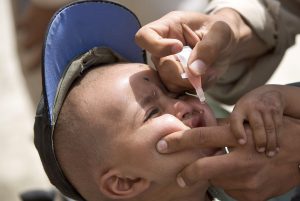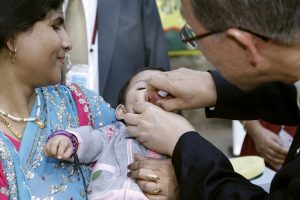The recent detection of the first wild polioviruses in Nigeria after two years is a sobering reminder that congressional support to eradicate polio must be maintained until the virus is eradicated for good, everywhere. Until 2012, Nigeria accounted for over half of the world’s polio cases. The country now hosts only a handful of cases in the remote corners of the Lake Chad basin. High quality vaccination campaigns and surveillance and response mechanisms have enabled this remarkable progress, but there is still work to be done. In order to wipe out this disease for good, U.S. legislators must continue to prioritize funding for polio eradication activities.
Recently, Congress took an important step in the right direction. House and Senate appropriations committees released bold FY17 bills in July with strong funding for global health programs. Among their priorities were a $40m increase for Gavi, the Vaccine Alliance and $59m for USAID’s polio eradication efforts, including $7.5 million for programs in Afghanistan and Pakistan. Combined with the $174 million recommended for CDC’s core polio eradication program work, prospects for a polio-free world are promising.
From the U.S. treasury to remote corners of high-risk countries
Through CDC and USAID appropriations, everyday Americans’ tax dollars are funding remarkable programs working to improve disease surveillance, community outreach, emergency response, and to train health workers in the fight to eradicate polio. It is precisely this type of ongoing surveillance that led to the detection of wild poliovirus in Nigeria, announced in August. Rapid detection, especially in conflict zones, significantly increases the Nigerian government and other partners’ capacity to mount an effective response and stop outbreaks. While the Nigeria outbreak is certainly a setback, past flare-ups in Syria and Somalia prove that stemming outbreaks in conflict zones is possible.
Similarly, U.S. support is helping to ensure that community health workers (CHWs) in Pakistan are equipped with the right training and supplies to reach the most remote corners of the country. These CHWs are on the frontlines of polio vaccination campaigns, going door-to-door to administer the polio vaccine to children. They have a close relationship with their community due to their integration in the community itself. CHWs live and work in the same area as the families they provide services for, enabling them to develop close relationships with community members and gain access to children that might otherwise be missed. If a child misses a vaccination due to illness, for instance, a CHW can follow up with the household after the child recovers. Or, if a family is hesitant to vaccinate due to misinformation or preconceptions about polio, the CHW is trained to provide education to the family to ease concerns. The CHWs’ dedication to reach every last child below the age of 5 is just what it will take to eradicate polio.
Conclusion
The U.S. has been a leader in global health investments for many years, and these programs funding health worker training, community outreach, and disease surveillance are propelling the world down the path to polio eradication. In a tough fiscal environment, these investments not only protect the most vulnerable from the devastating effects of polio – they represent a global health “best buy”.
Since the Global Polio Eradication Initiative (GPEI) was established in 1988, an upfront investment of $9 billion has netted a $27 billion return in economic benefits. Furthermore, polio vaccination workers continue to provide health services beyond polio vaccination; for instance, the provision of over 1.3 billion doses of Vitamin A to malnourished children generated $17 billion in economic returns from 1988 to 2010. As Americans, it is critical that we continue to advocate to our Members of Congress about these successes and the potential for funding the world’s next public health milestone – the eradication of polio once and for all.


